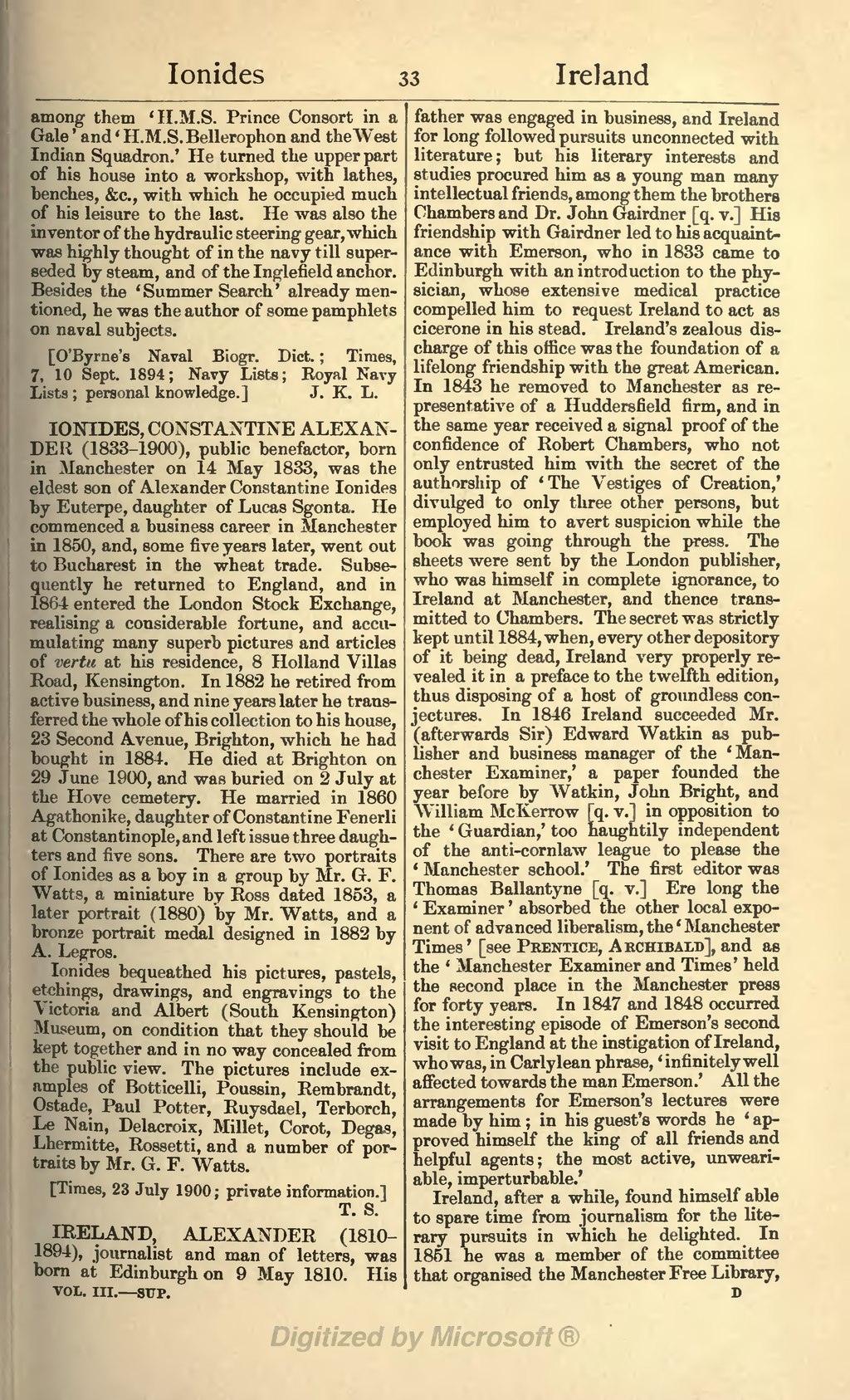among them 'H.M.S. Prince Consort in a Gale' and 'H.M.S. Bellerophon and the West Indian Squadron.' He turned the upper part of his house into a workshop, with lathes, benches, &c., with which he occupied much of his leisure to the last. He was also the inventor of the hydraulic steering gear, which was highly thought of in the navy till superseded by steam, and of the Inglefield anchor. Besides the 'Summer Search' already mentioned, he was the author of some pamphlets on naval subjects.
[O'Byrne's Naval Biogr. Dict. ; Times, 7, 10 Sept. 1894; Navy Lists; Royal Navy Lists; personal knowledge.]
IONIDES, CONSTANTINE ALEXANDER (1833–1900), public benefactor, born in Manchester on 14 May 1833, was the eldest son of Alexander Constantine Ionides by Euterpe, daughter of Lucas Sgonta. He commenced a business career in Manchester in 1850, and, some five years later, went out to Bucharest in the wheat trade. Subsequently he returned to England, and in 1864 entered the London Stock Exchange, realising a considerable fortune, and accumulating many superb pictures and articles of vertu at his residence, 8 Holland Villas Road, Kensington. In 1882 he retired from active business, and nine years later he transferred the whole of his collection to his house, 23 Second Avenue, Brighton, which he had bought in 1884. He died at Brighton on 29 June 1900, and was buried on 2 July at the Hove cemetery. He married in 1860 Agathonike, daughter of Constantine Fenerli at Constantinople, and left issue three daughters and five sons. There are two portraits of Ionides as a boy in a group by Mr. G. F. Watts, a miniature by Ross dated 1853, a later portrait (1880) by Mr. Watts, and a bronze portrait medal designed in 1882 by A. Legros.
Ionides bequeathed his pictures, pastels, etchings, drawings, and engravings to the Victoria and Albert (South Kensington) Museum, on condition that they should be kept together and in no way concealed from the public view. The pictures include examples of Botticelli, Poussin, Rembrandt, Ostade, Paul Potter, Ruysdael, Terborch, Le Nain, Delacroix, Millet, Corot, Degas, Lhermitte, Rossetti, and a number of portraits by Mr. G. F. Watts.
[Times, 23 July 1900; private information.]
IRELAND, ALEXANDER (1810–1894), journalist and man of letters, was born at Edinburgh on 9 May 1810. His father was engaged in business, and Ireland for long followed pursuits unconnected with literature; but his literary interests and studies procured him as a young man many intellectual friends, among them the brothers Chambers and Dr. John Gairdner [q. v.] His friendship with Gairdner led to his acquaintance with Emerson, who in 1833 came to Edinburgh with an introduction to the physician, whose extensive medical practice compelled him to request Ireland to act as cicerone in his stead. Ireland's zealous discharge of this office was the foundation of a lifelong friendship with the great American. In 1843 he removed to Manchester as representative of a Huddersfield firm, and in the same year received a signal proof of the confidence of Robert Chambers, who not only entrusted him with the secret of the authorship of 'The Vestiges of Creation,' divulged to only three other persons, but employed him to avert suspicion while the book was going through the press. The sheets were sent by the London publisher, who was himself in complete ignorance, to Ireland at Manchester, and thence transmitted to Chambers. The secret was strictly kept until 1884, when, every other depository of it being dead, Ireland very properly revealed it in a preface to the twelfth edition, thus disposing of a host of groundless conjectures. In 1846 Ireland succeeded Mr. (afterwards Sir) Edward Watkin as publisher and business manager of the 'Manchester Examiner,' a paper founded the year before by Watkin, John Bright, and William McKerrow [q. v.] in opposition to the 'Guardian,' too haughtily independent of the anti-cornlaw league to please the 'Manchester school.' The first editor was Thomas Ballantyne [q. v.] Ere long the 'Examiner' absorbed the other local exponent of advanced liberalism, the 'Manchester Times' [see Prentice, Archibald], and as the 'Manchester Examiner and Times' held the second place in the Manchester press for forty years. In 1847 and 1848 occurred the interesting episode of Emerson's second visit to England at the instigation of Ireland, who was, in Carlylean phrase, 'infinitely well affected towards the man Emerson.' All the arrangements for Emerson's lectures were made by him; in his guest's words he 'approved himself the king of all friends and helpful agents; the most active, unweariable, imperturbable.'
Ireland, after a while, found himself able to spare time from journalism for the literary pursuits in which he delighted. In 1851 he was a member of the committee that organised the Manchester Free Library,
